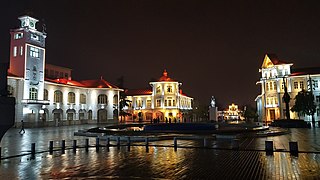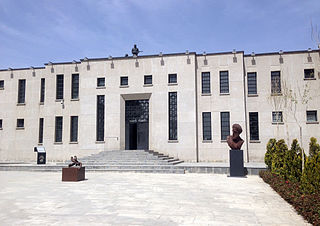
Babol, known as "Orange Blossom City;" also Romanized as Bābol; formerly known as Barfrouch, is a city in the Central District of Babol County, Mazandaran province, Iran, serving as capital of both the county and the district. Babol is divided into two metropolitan areas.

Rasht is a city in the Central District of Rasht County, Gilan province, in Iran. Rasht serves as capital of the province, the county, and the district. The city is also known as the "City of Rain" and, with a population of 679,995 in 2016, is the most populous city of northern Iran.

Morteza Motahhari was an Iranian Twelver Shia scholar, philosopher, lecturer. Motahhari is considered to have an important influence on the ideologies of the Islamic Republic, among others. He was a co-founder of Hosseiniye Ershad and the Combatant Clergy Association. He was a disciple of Ruhollah Khomeini during the Shah's reign and formed the Council of the Islamic Revolution at Khomeini's request. He was chairman of the council at the time of his assassination.

Valiasr Street, formerly known as the Pahlavi Street, is a tree-lined street in Tehran, dividing the metropolis into western and eastern parts which were built in 1922 to 1927 respectively, considering the end of asphalt plan it ended in 1933. It is considered one of Tehran's main thoroughfares and commercial centers. It is also the longest street in the Middle East, and was reported as one of the longest in the world by former BBC journalist Rageh Omaar during the television documentary Welcome to Tehran.

Jannat Abad is a large neighbourhood in Tehran, Iran. It is an area around the Jannat Abad Street located in North West Tehran. Jannat Abad street starts from Ayatollah Kashani Freeway. It has several squares. The most famous one is Chahar Bagh. Jannat Abad Blvd has a South segment that is below the cross with Hemmat Freeway and North part that is located upon Hemmat and links to the Marzdaran Freeway.

Ayatollah Mohammad Mofatteh was an Iranian philosopher, theologian, and political activist, born in Famenin, Hamadan, Iran. After he finished his primary education in Hamadan, he left for the Islamic Seminary in Qom, where he was taught by reputable teachers such as Ayatollah Muhammad Hujjat Kuh-Kamari, Ayatollah Sayyed Hossein Tabatabei Borujerdi, Grand Ayatollah Sayyid Ruhollah Mūsavi Khomeini, Ayatollah Mohammad-Reza Golpaygani, Ayatollah Marashi, and Allameh Tabatabie. He continued his studies at seminary and at the same time studied philosophy at Tehran University, where he earned his PhD and became a professor and a dean of colleague.

Abbās Ābād is a large north-central neighborhood of Tehran, Iran, designated within the Seventh Municipal District of the capital.

Farmanieh is a wealthy district located in northern Greater Tehran in the area named Shemiran. It lies within Shemiranat County and also district one of Tehran Municipality. Farmanieh has one of, if not the highest household income rates in Tehran, being home to many embassies, nobles and notables of Iran.
Velenjak is an affluent neighbourhood in the northwest of Tehran, Iran. Velenjak is located in the Shemiran area in the northernmost part of Tehran, on the slopes of the Alborz mountain range. It is known for its landscapes, mild climate, mountain air, springs, and wildlife.

Tajrish, also Romanized as Tajrīš, is a neighbourhood of Tehran, capital of Iran. Administratively it is in Shemiranat County, Tehran province and serves as the capital of the county. At one time a village, it was later absorbed into the city of Tehran.
Intellectual movements in Iran involve the Iranian experience of modernity and its associated art, science, literature, poetry, and political structures that have been changing since the 19th century.

Darrous is a neighborhood in Shemiran, northern Tehran, Iran. It is considered one of the most affluent areas in the city, as many modern and fashionable families reside there. Darrous is bounded by Pasdaran, Gholhak, Doulat, and Ekhtiyarieh.

Kamranieh is an affluent and luxury neighbourhood located in one of the northernmost parts of Greater Tehran in the area called Shemiran, on the slopes of Alborz mountain range. Kamranieh is known for its luxurious high-rise buildings, costly apartments and massive mansions. Centered on Kamranieh street, the neighborhood lies within Shemiranat County and district one of Tehran municipality.

The Museum of the Qasr Prison is a historical complex in Tehran, Iran.

Tehransar is the name of a neighborhood in the west of Tehran, which is connected to Shahid Lashkari highway and Shahrak Azadi neighborhood from the north, Fatah highway from the south, Mehrabad airport and Asman neighborhood from the east, and Ayatollah Mahdavi Keni highway and Esteghlal neighborhood and Darya neighborhood from the west. is limited. Tehransar neighborhood used to be in the 9th district of Tehran municipality, but since 2004 it is located in the 21st district of Tehran municipality. Girl schools in Tehranser have been the subject of gas poisonings in 2023, with dozens of students taken to hospital.
Gholhak Garden is a British overseas diplomatic compound in the northern Tehran neighborhood of Gholhak in Iran, about 3 miles (4.8 km) from the centre of Tehran. The sprawling tree-lined site, bordered by high walls, measures 200,000 square metres and houses British diplomats and their families. The compound is also home to the Tehran War Cemetery. The site has been at the centre of diplomatic controversy between Britain and Iran over ownership and management of the grounds.

The Embassy of the United Kingdom in Tehran is the United Kingdom's diplomatic mission to the Islamic Republic of Iran. It is located at 172 Ferdowsi Avenue in Tehran.

Oudlajan is a historic neighborhood in Tehran, Iran. The neighborhood is surrounded by Pamenar Street, Cyrus Street, Cheragh Bargh and BozarJomehr Street. Oudlajan, in addition to Arg, Dolat, Sangelaj, Bazar and Chalmeidan, constituted Old Tehran during the reign of Naser al-Din Shah Qajar. Old Oudlajan consisted of 2619 houses and 1146 shops and was one of the biggest and wealthiest neighborhoods in Tehran.















